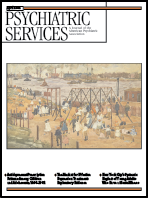Smoking Cessation for Geropsychiatric Patients in Long-Term Care
Smoking cessation programs have been largely successful with psychiatric patients, but our literature review found none that was conducted with psychiatric patients in a long-term-care setting. Here we describe our clinical experience in transforming a geropsychiatric nursing home and 29 of its patients from smoking to nonsmoking over the course of a year. Of these 29 patients, a majority were men (86 percent) and were white (79 percent). The patients' mean age was 66 years, and their mean score on the Mini-Mental State Examination was 22, indicating mild cognitive impairment. For a majority of the patients (86 percent), the primary psychiatric diagnosis was a psychotic-spectrum disorder.
After a fire caused by a patient's smoking in bed, staff concluded that the smoking policy needed to become more restrictive and that a designated smoking area outside the building should be established. During the first nine months of the new smoking cessation program, which began in August 2001, a two-tiered approach to smoking control was used. Eighteen higher-functioning patients—"safe smokers"—could continue smoking in a designated area. Eleven other patients—"unsafe smokers"—had to stop smoking. The "safe smokers" kept their cigarettes and lighters off the unit in keyed mailboxes near the front of the building and continued smoking on a trial basis to see whether they could independently purchase, manage, and store cigarettes; safely smoke only in the designated area; and refrain from giving cigarettes to the "unsafe smokers." These patients were informed that their compliance with these rules would determine whether they would be able to continue to smoke.
For the "unsafe smokers," the smoking cessation intervention used a combination of psychosocial and nicotine-replacement interventions. During the two weeks before the beginning of the smoking cessation program, smokers met daily with a psychologist, who reminded them about the upcoming quitting date. Starting with the first day of the program, each smoker was given a nicotine patch daily at 6 a.m. During the first two weeks of the program, the psychologist held a support group twice a day—after breakfast and after lunch. At these meetings patients discussed their cravings and ways of coping with them and were offered candy, gum, and diet soda.
Patients' outcomes varied by unit. Patients in the locked unit or on a ward where all patients had to stop smoking demonstrated no increase in psychosis or agitated behavior. When "unsafe smokers" had to stop smoking on units where "safe smokers" continued to smoke, some of the "unsafe smokers" became agitated and noncompliant, although they did not become more psychotic. The main trigger for their agitation was anger that some of their peers continued to smoke while they could not. The presence of the designated smoking area served as a trigger for relapse, because some ex-smokers repeatedly went to the designated area and obtained cigarettes from smokers and consequently had to be restricted to the ward. A few patients became so angry or agitated at the restriction that they required psychiatric hospitalization. Even some of the "safe smokers" brought their cigarettes back into the building and smoked in the restrooms or gave the cigarettes to "unsafe smokers" on the units.
Because of these problems, staff decided that the entire building should become nonsmoking and that the designated smoking area should be abolished. Six patients refused to stop smoking or were persistently noncompliant with cessation and thus were transferred to residential care homes or nursing homes in the community that permitted smoking. A year after the program began, all patients had ceased smoking or had been transferred.
To assess the program's psychiatric effects on patients who were forced to quit smoking, we compared the number of psychiatric hospitalizations and assaults during the six months before the patient stopped smoking with the number during the six months after the patient first stopped. Although the total number of psychiatric hospitalizations and assaults was small, assaults doubled and hospitalizations more than doubled from the pre- to the postintervention period. Although a chi square test showed that these increases were not statistically significant, we still considered them to be clinically important and thus sought to understand their causes. The data showed that most of the postintervention hospitalizations and assaults occurred during the time that the designated smoking area was in use.
Thus the most important clinical finding was that use of a designated smoking area for geropsychiatric patients in long-term-care settings was counterproductive and may have led to a temporary increase in the number of assaults and psychiatric hospitalizations. Although stimulus control is a very important part of a smoking cessation program for all patients, it is essential with this patient population.
The authors are affiliated with the Veterans Affairs Palo Alto Health Care System in Palo Alto, California. Dr. Kuhlman is also with the department of nursing at Ohlone College in Fremont, California. Send correspondence to Dr. Hartz at 324B4, MPD, Veterans Affairs Palo Alto Health Care System, 3801 Miranda Avenue, Palo Alto, California 94304 (e-mail, [email protected]).



